Copper isotope ratios in magmatic
- 格式:pdf
- 大小:844.52 KB
- 文档页数:14

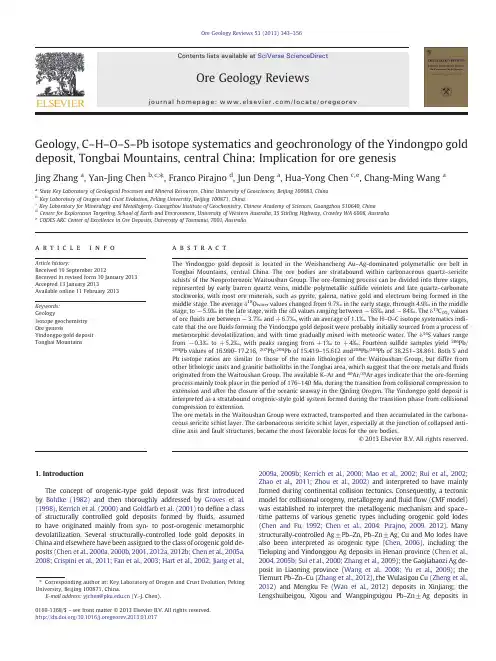
Geology,C –H –O –S –Pb isotope systematics and geochronology of the Yindongpo gold deposit,Tongbai Mountains,central China:Implication for ore genesisJing Zhang a ,Yan-Jing Chen b ,c ,⁎,Franco Pirajno d ,Jun Deng a ,Hua-Yong Chen c ,e ,Chang-Ming Wang aaState Key Laboratory of Geological Processes and Mineral Resources,China University of Geosciences,Beijing 100083,China bKey Laboratory of Orogen and Crust Evolution,Peking University,Beijing 100871,China cKey Laboratory for Mineralogy and Metallogeny,Guangzhou Institute of Geochemistry,Chinese Academy of Sciences,Guangzhou 510640,China dCentre for Exploration Targeting,School of Earth and Environment,University of Western Australia,35Stirling Highway,Crawley WA 6008,Australia eCODES ARC Center of Excellence in Ore Deposits,University of Tasmania,7001,Australiaa b s t r a c ta r t i c l e i n f o Article history:Received 19September 2012Received in revised form 10January 2013Accepted 13January 2013Available online 11February 2013Keywords:GeologyIsotope geochemistry Ore genesisYindongpo gold deposit Tongbai MountainsThe Yindongpo gold deposit is located in the Weishancheng Au –Ag-dominated polymetallic ore belt in Tongbai Mountains,central China.The ore bodies are stratabound within carbonaceous quartz –sericite schists of the Neoproterozoic Waitoushan Group.The ore-forming process can be divided into three stages,represented by early barren quartz veins,middle polymetallic sul fide veinlets and late quartz –carbonate stockworks,with most ore minerals,such as pyrite,galena,native gold and electrum being formed in the middle stage.The average δ18O water values changed from 9.7‰in the early stage,through 4.9‰in the middle stage,to −5.9‰in the late stage,with the δD values ranging between −65‰and −84‰.The δ13C CO 2values of ore fluids are between −3.7‰and +6.7‰,with an average of 1.1‰.The H –O –C isotope systematics indi-cate that the ore fluids forming the Yindongpo gold deposit were probably initially sourced from a process of metamorphic devolatilization,and with time gradually mixed with meteoric water.The δ34S values range from −0.3‰to +5.2‰,with peaks ranging from +1‰to +4‰.Fourteen sul fide samples yield 206Pb/204Pb values of 16.990–17.216,207Pb/204Pb of 15.419–15.612and 208Pb/204Pb of 38.251–38.861.Both S and Pb isotope ratios are similar to those of the main lithologies of the Waitoushan Group,but differ from other lithologic units and granitic batholiths in the Tongbai area,which suggest that the ore metals and fluids originated from the Waitoushan Group.The available K –Ar and 40Ar/39Ar ages indicate that the ore-forming process mainly took place in the period of 176–140Ma,during the transition from collisional compression to extension and after the closure of the oceanic seaway in the Qinling Orogen.The Yindongpo gold deposit is interpreted as a stratabound orogenic-style gold system formed during the transition phase from collisional compression to extension.The ore metals in the Waitoushan Group were extracted,transported and then accumulated in the carbona-ceous sericite schist layer.The carbonaceous sericite schist layer,especially at the junction of collapsed anti-cline axis and fault structures,became the most favorable locus for the ore bodies.©2013Elsevier B.V.All rights reserved.1.IntroductionThe concept of orogenic-type gold deposit was first introduced by Bohlke (1982)and then thoroughly addressed by Groves et al.(1998),Kerrich et al.(2000)and Goldfarb et al.(2001)to de fine a class of structurally controlled gold deposits formed by fluids,assumed to have originated mainly from syn-to post-orogenic metamorphic devolatilization.Several structurally-controlled lode gold deposits in China and elsewhere have been assigned to the class of orogenic gold de-posits (Chen et al.,2000a,2000b,2001,2012a,2012b;Chen et al.,2005a,2008;Crispini et al.,2011;Fan et al.,2003;Hart et al.,2002;Jiang et al.,2009a,2009b;Kerrich et al.,2000;Mao et al.,2002;Rui et al.,2002;Zhao et al.,2011;Zhou et al.,2002)and interpreted to have mainly formed during continental collision tectonics.Consequently,a tectonic model for collisional orogeny,metallogeny and fluid flow (CMF model)was established to interpret the metallogenic mechanism and space –time patterns of various genetic types including orogenic gold lodes (Chen and Fu,1992;Chen et al.,2004;Pirajno,2009,2012).Many structurally-controlled Ag±Pb –Zn,Pb –Zn±Ag,Cu and Mo lodes have also been interpreted as orogenic type (Chen,2006),including the Tieluping and Yindonggou Ag deposits in Henan province (Chen et al.,2004,2005b;Sui et al.,2000;Zhang et al.,2009);the Gaojiabaozi Ag de-posit in Liaoning province (Wang et al.,2008;Yu et al.,2009);the Tiemurt Pb –Zn –Cu (Zhang et al.,2012),the Wulasigou Cu (Zheng et al.,2012)and Mengku Fe (Wan et al.,2012)deposits in Xinjiang;the Lengshuibeigou,Xigou and Wangpingxigou Pb –Zn±Ag deposits inOre Geology Reviews 53(2013)343–356⁎Corresponding author at:Key Laboratory of Orogen and Crust Evolution,Peking University,Beijing 100871,China.E-mail address:yjchen@ (Y.-J.Chen).0169-1368/$–see front matter ©2013Elsevier B.V.All rights reserved./10.1016/j.oregeorev.2013.01.017Contents lists available at SciVerse ScienceDirectOre Geology Reviewsj ou r n a l h o m e p a g e :w w w.e l s e v i e r.c o m /l o c a t e /o r e g e or e vHenan province(Qi et al.,2007,2009;Yao et al.,2008);the Bainaimiao Cu±Au deposit in Inner Mongolia(Li et al.,2008);and the Zhifang Mo (Deng et al.,2008),the Dahu Mo–Au(Li et al.,2011a;Ni et al.,2008, 2012)and the Longmendian Mo(Li et al.,2011b)deposits in Henan province.Recent advances have not only improved the understanding of ore genesis and exploration targeting in orogenic belts,but also intro-duced several new uncertainties.One of them is whether the orogenic type deposit can occur as stratabound style;if not,how to clarify the ge-netic type of deposits formed by metamorphic ore-formingfluids that focused in specific lithologies(e.g.,carbonaceous beds,stratigraphic un-conformities);and if so,what are the geochemical signatures and metal sources of these stratabound orogenic-type deposits.Several gold de-posits,such as Muruntau in Uzbekistan,Kumtor in Kyrgyzstan,Sukhoi Log in Russia,Homestake in USA(Bierlein and Maher,2001;Goldfarb et al.,2001)and Sawayardun in Xinjiang(Chen et al.,2012a,b;Liu et al.,2007),Yangshan in Gansu(Yang et al.,2006,2009)and Yindongpo in Henan(Chen,1995;Zhou et al.,2002),show stratabound characteris-tics but alsofit an orogenic-style of mineral system.In this contribution we report the results of studies on the Yindongpo gold deposit,which occurs in the Weishancheng ore belt in Tongbai Mountains,Henan province,central China(Zhang et al., 2011).The Yindongpo deposit contains32,337kg Au at an average grade of7.61g/t,130.5t Ag at an average grade of38.41g/t, and26,792t Pb at an average grade of0.95%(Zhang Guan,pers. comm.).The deposit is characterized by a stratabound to stratiform ge-ometry,and has attracted the interest of geologists for its metallogenic style,ore genesis,spatial distribution and economic potential(Chen and Fu,1992;HBGMR,1985;Hu et al.,1988;Luo,1992;Xu et al.,1995; Zhang et al.,2009).However,an integrated study on the deposit has not been reported as yet.This paper summarizes the geology and H–O–C–S stable and radiogenic isotopic systematics of the Yindongpo gold deposit,and discusses the sources of ore metals andfluids,as well as the ore-forming mechanism(s).2.Geological setting2.1.Regional geologyThe Tongbai Mountains are part of the Central China Orogen (Fig.1A)that was formed during the Mesozoic collision between the Yangtze and North China continents(Wu and Zheng,2012),with the Shang-Dan fault zone being interpreted as main suture(Fig.1B).The Shang-Dan suture zone comprises ophiolite slices and Paleozoic–Triassic sediments,the latter containing radiolarian fossils(Du et al., 1997;Feng et al.,1994).North of the Shang-Dan suture is the northern Qinling accretionary belt(Chen et al.,2009)that includes the Qinling Metamorphic Complex,the Erlangping and Kuanping terranes.These terranes are south of the Luanchuan fault,which is accepted as the boundary between the Qinling Orogen and the reactivated southern margin of the North China Craton(Fig.1B).The Qinling Metamorphic Complex comprises the Qinling Group(pre-Rodinian metamorphic basement)and Neoproterozoic to Paleozoic granitoids which were mostly formed in magmatic-arc settings.The Erlangping terrane, which hosts the Weishancheng ore belt,is bound by the Zhu-Xia fault to south and the Waxuezi fault to north(Fig.1B,C),and mainly com-prises Neoproterozoic–Early Paleozoic volcano-sedimentary succes-sions and associated intrusions that formed in a back-arc basin(Chen et al.,2004;Hu et al.,1988;Sun et al.,2002).In the Kuanping terrane, the Kuanping Group mainly consists of Mesoproterozoic muscovite–biotite(quartz)schists,metagabbros,basaltic rocks and ophiolite slices, and is interpreted as a Mesoproterozoic ophiolite complex accreted to the southern margin of North China Craton(Gao et al.,1991;He etal.,Fig.1.Schematic map showing the geology of the Tongbai Mountains(Zhang et al.,2011).A)Location of the Qinling–Tongbai–Dabie Mountains.B)Tectonic framework of the Qinling–Tongbai–Dabie Mountains.C)Geology of the Tongbai Mountains and the location of the Yindongpo gold deposit.SDF,Shang-Dan suture zone;MLF,Mian-Lue suture zone.SBF,San-Bao fault;F1,Machaoying fault;F2,Luanchuan fault;F3,Waxuezi fault;F4,Zhu-Xia fault;F5,Tong-Shang fault;F6,Tan-Lu fault;F7,Duanzhuang(Duanzhuang–Duimenchong)fault.344J.Zhang et al./Ore Geology Reviews53(2013)343–3562009;Hu et al.,1988;Luo,1992;Zhao et al.,2004,2009).The Kuanping Group is locally covered by or interleaved with Neoproterozoic to Early Paleozoic metamorphic sediments,and thereby is interpreted to have developed in Neoproterozoic or Early Paleozoic(Chen et al.,2009;and reference therein).The Weishancheng Au–Ag-dominated polymetallic ore belt in the northern Tongbai Mountains,strikes WNW for about20km with a width of ca.1km,and is located in the Erlangping terrane,north of the Zhu-Xia fault(F4in Fig.1C).Its eastern and western extensions are covered by Wucheng and Nanyang Cenozoic basins,respectively. The ore belt contains the Yindongpo Au deposit,the Poshan Ag deposit and the Yindongling Ag-dominated polymetallic deposit,as well as nu-merous small ore deposits or occurrences(Figs.1and2).2.2.Local geologyAll the deposits and occurrences in the Weishancheng ore belt are hosted in low-grade metamorphic carbonaceous rocks of the Waitoushan Group(Figs.1and2),which has a total thickness of about2500m and consists of mica schist,quartz–mica schist,plagioclase–amphibole schist, marble and minor quartzite.The Waitoushan Group is divided into the Upper Waitoushan,Mid-dle Waitoushan and Lower Waitoushan Formations(abbreviated as UWF,MWF and LWF respectively in the following text andfigures), each containing several members(Fig.3).The UWF is mainly composed of quartz–mica schist.The MWF comprises plagioclase–amphibole schist and carbonaceous quartz–sericite schist.The LWF contains more plagioclase–amphibole schist and marble.In the Tongbai Mountains,the Waitoushan Group is unique for its high abundance of organic carbon,Au,Ag and other metallic elements(Chen and Fu, 1992;HBGMR,1994).The Yindongpo gold deposit is hosted in the sec-ond member of MWF(Fig.3).The axis of the Heqianzhuang anticline strikes90°–120°,and is subparallel with the regional faults(Fig.2).This anticline comprises the Waitoushan Group and Dalishu Formation of the Erlangping Group.The anticlinal axis dies to the east and the hinge plunges towards the west.The Waitoushan Group occurs along the axis of the anticline,whereas the Dalishu Formation forms its southern limb.The orebodies are mainly sited in the hinge and/or along the two limbs of the anticline(Figs.2B,4,5A,C).The NW-trending faults are the dominant regional structures,and are crosscut by the ENE-trending,post-ore faults(Fig.2A).The largest fault is labeled F1and controls the Yindongpo deposit(Fig.2B).The anticline was intruded by granitic plutons,such as the Taoyuan Paleozoic granodiorite pluton and Liangwan monzogranite pluton.The Taoyuan granodiorite yields biotite K–Ar ages of390–357Ma,with the magma being sourced from the basement of northern Qinling accre-tionary belt(Zhang et al.,1999,2000).It intruded the Erlangping Group and Early Paleozoic quartz diorite then was intruded by granites,such as the Liangwan pluton,of Mesozoic age(Yanshanian;see below) (Figs.1and2).The Liangwan monzogranite pluton intruded the Dalishu Formation of the Erlangping Group(Figs.1and2)at128–111Ma(bio-tite K–Ar,whole rock Rb–Sr isochrones)and originated from partial melting of the Tongbai complex in southern Qinling terrane,implying that the lower crust of northern Tongbai Mountains(corresponding to northern Qinling accretionary belt)contains the components fromtheFig.2.Schematic map showing regional and ore geology of the Yindongpo Au deposit.A)Geology of the Weishancheng ore belt after Zhang et al.(2011).B)Geology and distribution of the Yindongpo orebodies,modified after HBGMR(1994).Abbreviations:XLZ,Xialaozhuang;GLZ,Guolaozhuang;ZZ,Zhangzhuang;LJC,Luanjiachong;JZ,Jiangzhuang;WG,Weigou;NXG, Nanxiaogou;ZhZ,Zhuzhuang.345J.Zhang et al./Ore Geology Reviews53(2013)343–356southern Qinling terrane,via a northward-directed continental subducting slab (Zhang et al.,1999,2000,2011).3.Deposit geology3.1.Characteristics of the orebodiesThe Yindongpo gold deposit covers an area 2km long and 0.6–0.9km wide (Fig.2B).The distribution of the orebodies is strictly con-trolled by carbonaceous beds (graphite-rich quartz –sericite schists)and the Heqianzhuang anticline and fault systems (Figs.2and 4A).The orebodies are typically stratabound and lenticular in shape,or occur as saddles and veins,and generally dip with the hosting strata (Fig.2B).The orebodies in the northern limb of the anticline are steeper than those in the southern limb (Fig.2B).The contacts between orebodies and wallrocks are gradational and are determined by a cut-off grade.The depth of orebodies increases from southeast to northwest.Most of orebodies are hosted in the second member of MWF (Figs.2B,3and 4),especially in the silici fied quartz –sericite schist and/or carbonaceous quartz –sericite schist.The No.0exploration line divides the Yingdongpo deposit into east-ern and western sectors.The eastern sector contains 19ore bodies,with Nos.1,2,3and 3–1being thick,long and continuously mineralized (Figs.2B and 4).In the western ore sector,Nos.51,52,54and 55are the most important orebodies,but are thinner,smaller and less contin-uously mineralized than those in the eastern sector (Figs.2B and 4).The No.1orebody is the largest,with Au reserves accounting for 78%of the ore in eastern sector (HBGMR,1994).It is 1600m long,600m deep and 8m wide,with average grades of 6.23g/t Au and 50g/t Ag,respectively.The ores were mined by open pitting and underground operation.3.2.Ore types and ore mineral assemblagesAltered tectonite breccia,fine vein-disseminated silici fied schist,and silici fied (carbonaceous)quartz –sericite schist (Fig.5),are all Au,Ag,Fe,Cu,Sb,As,Bi,Pb,Zn,Co and Sn enriched,but only Au attained suf ficient ore grades to be economically extracted.Ore minerals include sul fides,native elements,sulfates and oxides (Fig.5),such as pyrite,chalcopy-rite,sphalerite,galena,native gold,electrum and argentite,and ac-counting for up to 10%of the ore by volume.Gangue minerals are mainly quartz,sericite and carbonate.Fine-grained graphite is com-monly present in the ores (Fig.5D).Cataclastic textures and fissure-fillings are commonly observed.Stockworks,veinlets,disseminations,and banded ores are the main ore styles (Fig.5).3.3.Mineralization stages and wallrock alterationOn the basis of the paragenetic sequences of minerals (Fig.6),ore petrography and crosscutting relationships,the ore-forming process can be divided into three stages,namely,an early-stage barren quartz veins or replacement with or without pyrite (Fig.5F),a middlestageFig.3.Lithostratigraphy and ore metal concentrations of the Waitoushan Group.From HBGMR (1994).346J.Zhang et al./Ore Geology Reviews 53(2013)343–356with polymetallic sul fides (Fig.5G,H),and a late stage of quartz –carbonate veinlets (Fig.5I).Abundant pyrite,galena,native gold,electrum and other ore minerals formed in the middle stage.Three stage fluid –rock interactions resulted in wallrock alteration,mainly including silici fication,sericitization,carbonation and chloritization.Silici fication is the most prominent and in the early stage it was pervasive.Locally,the wallrocks were completely re-placed by fine-grained quartz with minor sericite,forming sericite-bearing siliceous replacement and/or quartz veins.In this case,the primary fabrics of wallrocks,such as schistosity and cleavage,cannot be observed because they were obliterated by pervasive silici fication.In general,ore grades increase with increasing intensity of hydrother-mal alteration.4.Samples and analytical methodsMost samples in this study were collected from No.1orebody at Levels of 155,145,115and 75(the digits represent the meters above the sea level).Sampling was carried out taking into account the field recognition of lateral zonation and the three-stage evolution of the mineralization.Rock samples collected from different strata were pulverized in an agate mill under 200meshes.Mineral aggregates were taken from the specimens using tweezers and then were crushed into grains with sizes of 0.1–0.5mm.After panning and filtration,clean mineral grains (quartz,calcite,and sul-fides)were handpicked under the binocular microscope.In order to eliminate other interlocking minerals (e.g.sul fides),quartz separates were soaked in HNO 3-solution at a temperature between 60and 80°C for 12h and rinsed with deionized water.Then the separates were treated 6times using supersonic centrifugal clari fier and rinsed with deionized water for a week.The last rinsed water was monitored by an atomic absorption spectrophotometer to con firm that no ions were left.The samples were dried in an oven before analysis.For sul fides,approximately 10to 50mg were first leached in acetone to remove surface contamination and then washed by distilled water and dried at 60°C in the oven.The carbonate separates were only washed by distilled water and dried at 60°C in the oven.The analytical methods were explained in detail by Ding (1988).The carbon isotopic composition of fluid inclusion was measured on CO 2.Separated from fluid inclusions in quartz and calcite during thermal decrepitation,the CO 2gas was collected and condensed using a liquid nitrogen-alcohol cooling trap (−70°C)for analysis on a MAT-252mass spectrometry.Hydrogen isotope analysis of water contained in fluid in-clusions was collected in a similar manner.After collection the water was puri fied and then reduced using zinc to produce hydrogen which was analyzed on a MAT-253mass spectrograph.To measure oxygen iso-tope ratios,quartz separates were reacted with BrF 5at 500–550°C for at least 5h to generate O 2which was condensed using liquid nitrogen.The collected O 2was converted to CO 2at about 700°C with platinum as cat-alyzer,and then the CO 2was analyzed on MAT-252mass spectrometry.Sulfur isotope ratios in sul fides were analyzed on SO 2using Delta-S mass spectrometer.For lead isotope ratios,approximately 10to 50mg of sul fide samples was first leached in acetone to remove surface contamination and then washed by distilled water and dried at 60°C in the oven.Washed sul fides were dissolved in dilute mix solution of nitric acid and hydro fluoric acid.Following ion exchange chemistry,the lead in the solution was loaded onto rhenium filaments using a phosphoric acid –silica gel emitter.The lead isotopic compositions were measured on MAT-261thermal ioniza-tion mass spectrometer with the standard sample NBS 981.The H –O –C isotopes were measured in the State Key Laboratory of Lithosphere Evolution,Institute of Geology and Geophysics,Chinese Academy of Science.Isotopic data were reported in per mil relative to the Vienna SMOW standard for oxygen and hydrogen,and the Peedee Belemnite limestone (PDB)standard for carbon.Both sulfur and lead isotope analyses were finished at the Open Laboratory of Iso-topic Geochemistry,Chinese Academy of Geological Sciences.The Sul-fur isotopic compositions were reported relative to the Canyon Diablo Triolite (CDT)standard.Total uncertainties were estimated to be bet-ter than ±0.2‰for δ18O,±2.0‰for δD,±0.2‰for δ13C,and ±0.2‰for δ34S at the σlevel respectively.Estimated precision for the 206Pb/204Pb,207Pb/204Pb and 208Pb/204Pb ratios is about 0.1%,0.09%and 0.30%at the 2σlevel respectively.The K –Ar isochron age was analyzed by RGA-10dating system in Key Laboratory of Orogen and Crust Evolution,PekingUniversityFig.4.Simpli fied exploration sections showing orebodies of the Yindongpo Au deposit.Modi fied after HBGMR (1994).347J.Zhang et al./Ore Geology Reviews 53(2013)343–356and the systematic error of K –Ar dating is estimated to be b 4%.The 40Ar/39Ar plateau age was analyzed at the Geochronology Research Laboratory of Queen's University,Ontario,Canada.40Ar/39Ar analyses were performed by standard laser step-heating techniques described in detail by Clark et al.(1998).All data have been corrected for blanks,mass discrimination,and neutron-induced interferences.A plateau age is obtained when the apparent ages of at least three consecutive steps,comprising a minimum of 55%of the 39Ar k released,agreeFig.5.Geology,ore type and mineral assemblages of the Yindongpo gold deposit.A)Heqianzhuang anticline axis shown at an open pit;B)ore-hosting fault developed along the boundary between carbonaceous schist and two-mica schist;C)north limb of the No.55orebody (30°∠60°)and its foot-and hanging-walls;D)a small-size anticline in altered carbonaceous quartz schist;E)pyrite-bearing quartz veinlets in carbonaceous quartz schist;F)early-stage barren,milky quartz vein;G)pyrite-rich,high-grade ore;H)middle-stage ore rich in pyrite and galena;I)late-stage quartz-carbonate vein;J)chalcopyrite armored with covellite;K)euhedral pyrite in quartz;L.pyrite with cataclastic texture;M)sphalerite with thin film of tiny galena;N)sphalerite containing chalcopyrite droplets,forming exsolution texture;O)early-stage pyrite replaced by galena.348J.Zhang et al./Ore Geology Reviews 53(2013)343–356within 2σerror with the integrated age of the plateau segment.Errors and isotope-correlation diagrams represent the analytical precision at ±2σ.5.Isotope systematics 5.1.Hydrogen –oxygen isotopesThe δD and δ18O values for the Yindongpo ore deposit are listed in Table 1.The δ18O water was calculated according to the δ18O mineral and trapping temperature of fluid inclusion which was estimated according to homogenization temperature and its pressure correlation.The fluids of early-stage quartz (sample 99H09)have an δ18O water value of about +10.6‰,higher than the maximum for magmatic water,suggesting that the fluids were sourced from metamor-phic devolatilization rather than magmatism (Chen et al.,2005b,2008).It is common knowledge that magmatic fluids are generated from the magma above the temperature of 573°C (lowest eutectic point).The δ18O water ratio of the initial magmatic fluids is not higher than the δ18O quartz of the equilibrated magmatic rocks,due to 1000ln αquartz –water >0when T b 724°C.Hence the maximum δ18O water value of magmatic water was estimated to be 9‰(Fig.7).During continuous cooling and water –rock reaction processes,the δ18O water of magmatic water was reduced again along with the formation of hy-drothermal minerals such as quartz.If the fluids forming the Yindongpo deposit were initially magmatic and still kept δ18O water =+10.6‰when the temperature decreased to 414°C,their initial δ18O water must be far higher than 10.6‰.Such δ18O water value is obviously higher than the estimated maximum for magmatic water,also higher than the δ18O values of granitoids in Qinling –Tongbai Mountains,which range 6.1‰–10.4‰(Chen et al.,2000b ).Thus,the early stage fluid must be metamorphic in origin,instead of magmatic or meteoric,which is further supported by sulfur and lead isotope signatures,discussed ahead.The δ18O values of the middle-stage fluids range from +3.1‰to +5.5‰,averaging +4.9‰;whereas the δD values range from −68‰to −84‰,and average −75‰.Compared to the early-stage fluids,sam-ples of the middle-stage fluids clearly shift towards the meteoric water line (Fig.7),suggesting a signi ficant input of meteoric water into the fluid system.The δ18O water values of late-stage quartz and calcite are between −8.1‰and −3.7‰,averaging −5.9‰.Such low δ18O water values strong-ly indicate that the fluids were mainly sourced from meteoric water.Con-sidering the δD ratios in fluids vary in a narrow range (−65to −85‰)in early and middle stages,we estimate that the late stage δD water values are similar to the middle stage.These measured and estimated δD water values are close to that of Mesozoic meteoric water in Qinling Moun-tains (Fig.7).Assuming that the average δD water value of the late stage is same to that of the middle stage,the late stage samples are close to or shift towards the meteoric water line,especially to the domain of Mesozoic meteoric water in Qinling mountain range (Fig.7),which was drawn by Zhang (1989)from a H –O isotope geochemical study of numerous meteoric hydrothermal deposits formed in Mesozoic.This suggests that the late stage fluids are of meteoric origin.In conclusion,the average δ18O Water values changed from 9.7‰in the early stage,through 4.9‰in the middle stage and −5.9‰in the late stage,with the δD values ranging between −60‰and −90‰,strongly support that the ore fluids of the Yindongpo gold deposit were initially sourced from metamorphic devolatilization,and later changed to mainly meteoric water,from the early to the late stages of the mineralization process.5.2.Carbon isotopesThe δ13C CO 2values of the early-and middle-stage fluids forming the Yindongpo Au deposit widely vary between −3.7‰and +6.7‰,with an average of 1.1‰(Table 1).These values are higher than those of organic matter (ca.−27‰),atmospheric CO 2(−7to −11‰;Hoefs,2004),freshwater carbonate (−9to −20‰:Hoefs,2004),igneous rocks (−3to −30‰:Hoefs,2004;Zheng,1999),continental crust (−7‰:Faure,1986)and the mantle (−5to −7‰:Hoefs,2004);and therefore,the CO 2in the fluids forming the Yindongpo mineral system cannot independently have been supplied by any one or a mixture of the above-mentioned reservoirs.The marine carbonate,which is the carbon reservoir with highest δ13C value (ca.0.5‰;Schidlowski,1998),must be considered as the source of CO 2in the ore fluids,at least as a necessary end-member,considering that released CO 2via decarbonation could have higher δ13C than the residue carbonates (Jiang et al.,2004;Tang et al.,2011,in press ).The δ13C values of the carbonates in Waitoushan Group range from +1.9‰to +2.9‰(Table 1),suggesting that they most likely provided CO 2(with the highest δ13C value of 6.7‰)for the Yindongpo ore fluid-system via metamorphic de-carbonation.The δ13C values of calcite in late-stage veins at Yindongpo deposit range from −2.4‰to −0.6‰(Table 1),and correspond to the δ13C CO 2values of −2.8‰to −1.0‰calculated using the carbon isotope fractionation equation of for calcite –CO 2system (Chacko et al.,1991).The calculated δ13C CO 2values are lower than the δ13C CO 2values of ore-forming fluids in early and middle stages,suggesting that the fluid system was mixed with or replaced by meteoric water,which ef ficiently reduced the δ13Cvalue.Fig.6.Paragenetic sequence for major minerals of the Yindongpo Au deposit.349J.Zhang et al./Ore Geology Reviews 53(2013)343–356。
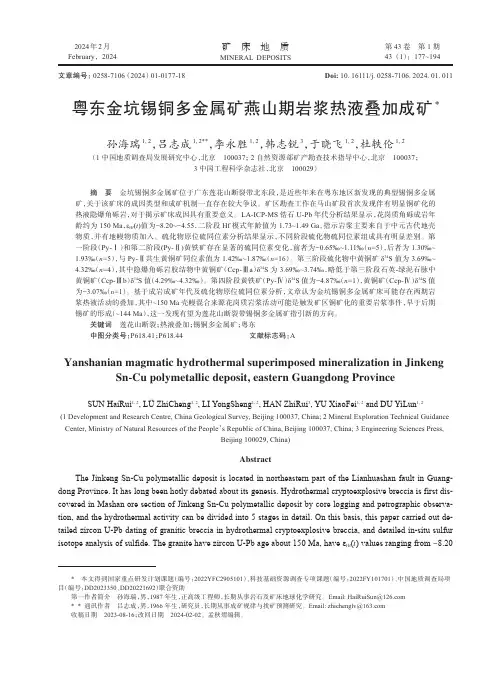
矿床地质MINERAL DEPOSITS2024年2月February ,2024第43卷第1期43(1):177~194*本文得到国家重点研发计划课题(编号:2022YFC2905101)、科技基础资源调查专项课题(编号:2022FY101701)、中国地质调查局项目(编号:DD2023350、DD20221692)联合资助第一作者简介孙海瑞,男,1987年生,正高级工程师,长期从事岩石及矿床地球化学研究。
Email:*******************通讯作者吕志成,男,1966年生,研究员,长期从事成矿规律与找矿预测研究。
Email:******************收稿日期2023-08-16;改回日期2024-02-02。
孟秋熠编辑。
文章编号:0258-7106(2024)01-0177-18Doi:10.16111/j.0258-7106.2024.01.011粤东金坑锡铜多金属矿燕山期岩浆热液叠加成矿*孙海瑞1,2,吕志成1,2**,李永胜1,2,韩志锐3,于晓飞1,2,杜轶伦1,2(1中国地质调查局发展研究中心,北京100037;2自然资源部矿产勘查技术指导中心,北京100037;3中国工程科学杂志社,北京100029)摘要金坑锡铜多金属矿位于广东莲花山断裂带北东段,是近些年来在粤东地区新发现的典型锡铜多金属矿,关于该矿床的成因类型和成矿机制一直存在较大争议。
矿区勘查工作在马山矿段首次发现伴有明显铜矿化的热液隐爆角砾岩,对于揭示矿床成因具有重要意义。
LA-ICP-MS 锆石U-Pb 年代分析结果显示,花岗质角砾成岩年龄约为150Ma ,εHf (t )值为-8.20~-4.55,二阶段Hf 模式年龄值为1.73~1.49Ga ,指示岩浆主要来自于中元古代地壳物质,并有地幔物质加入。
硫化物原位硫同位素分析结果显示,不同阶段硫化物硫同位素组成具有明显差别。
第一阶段(Py-Ⅰ)和第二阶段(Py-Ⅱ)黄铁矿存在显著的硫同位素变化,前者为-0.65‰~1.11‰(n =5),后者为1.30‰~1.93‰(n =5),与Py-Ⅱ共生黄铜矿同位素值为1.42‰~1.87‰(n =16)。

矿业英语(蒋林筛选)abnormality 反常一般说anormaly的人更多吧adit 平硐adit collar 平硐口adit cut mining 平硐开采adit entrance 平硐口adit mine 平硐开采矿山adit mouth 平硐口adjoining rock 围岩正常人说country rock吧advance bore 超前钻孔也有说pilot hole的agglomeration 聚集air adit 通风平硐就是air wayair drill 风钻air pick 风镐air pipe 风管air shaft 风井airleg 气腿风钻听起来更像汉语alluvial gold 砂金更常见的说法是placer alluvium 冲积层ammon dynamite 硝安炸药ammon explosive 硝铵炸药amphibole 角闪石analyst 化验员assayer更准确点anchor bolt 锚杆angle of bedding 层理面倾斜角anticline 背斜anticlinorium 复背斜antimony 锑assay 试金正常人都叫化验automatic feed 自动给料automatic feeder 自动给矿机automatic installation 自动设备auxiliary adit 辅助平峒auxiliary equipment 辅助设备auxiliary fan 辅助扇风机auxiliary level 辅助平巷auxiliary shaft 辅助竖井azimuth angle 方位角back bolting 顶板锚杆支护back filling 充填back stoping 上向梯段回采ball mill 球磨机band ore 带状矿石bank height 台阶高度barrier pillar 安全煤柱这个就叫safety pillar也行basalt 玄武岩base charge 基本装药量;炮眼底部装约bearing 煤层走向;轴承bed 地层belt feeder 带式给矿机beneficiating method 选矿法bin 矿仓biotite 黑云母bit 钎头就叫钻头也行blast hole 炮眼blasting charge 装炸药blind shaft 暗井正常人都说盲井block 采区;块;滑车组block caving method 分段崩落采矿法正确说法是sublevel caving board and pillar 房柱式开法跟room and pillar是一样的bolting 锚杆支护borehole 钻孔borehole survey 钻孔测量boring bar 钻杆drillrodbornite 斑铜矿bottom dump skip 底卸式箕斗bottom wall 下盘正确说法是heading wall 或footwallbucket excavator 多斗挖掘机bulldozer 推土机cage 罐笼calcite 方解石calculation of reserves 储量计算capstan winch 绞盘carbonaceous 炭质的casing pipe 套管caved area 崩落区cement 水泥charge 装药chloride 氯化物chute 溜道circuit 回路classification screen 分级筛classifier overflow 分级机溢流clay 粘土clay band 粘土夹层clay bed 粘土层cleaning 精浮选就是精选没有浮cleavage 劈理closed circuit crushing 闭路破碎collar cave 井颈塌落combustion 燃烧common drift 共用平巷compressed air 压缩空气compressor 压缩机concentrate 精矿contaminated air 污浊空气contour map 等高线图control 第;操纵;治理conveyor 运输机copper 铜core 岩心core sample 岩心试样coring 岩心钻进crack 裂缝crane 起重机cross adit 石门cross cutting 石门掘进cross level 横巷crush 破碎crusher 破碎机crusher jaw 破碎机颚crushing rolls 辊碎机crystal 晶体curvature 曲率cushioning 缓冲cuthole 掏槽炮眼cyanide 氰化物dacite 英安岩daily advance 日掘进进度day drift 平硐day output 日产量degree of extraction 回采率正确说法是recovery dehydration 脱水dehydrator 脱水器deister table 垂特摇床delamination 剥离delay 迟滞delay action blasting 迟发爆破densification 浓缩deposition 沉淀depot 仓库desulphurization 脱硫detonate 起爆detonating charge 起爆装药detonating cord 导爆线detonator 雷管developement drift 开拓平巷diagram 曲线图diameter 直径diamond 金刚石diesel electric locomotive 柴油电机车dike 岩脉dilution 稀释注意这个大部分时间翻译为贫化diorite 闪长岩dioxide 二氧化物dip angle 倾角directional drilling 定向钻进discontinuity 不连续性dissolubility 溶解性dissolvent 溶剂ditch 沟道dolomite 白云石drain 排水管drill bar 钻杆drill bit 钎头drill rig 钻车drill rod 钻杆drilling jumbo 钻车dry assay 干法试金dump car 翻斗车elastic 弹性的elastic strain 弹性应变electrum 银金矿engineering 工程entry 水平巷道entry advance 平巷推进entry bottom 平巷底entry brushing 巷道挑顶entry driving 平巷掘进entry pillar 平巷煤柱environment 环境environment pollution 环境污染environment protection 环境保扩evaporation 蒸发exploration 探矿explosion 爆炸explosive 炸药extraction 采掘extraction drift 回采平巷eye survey 目测face 叫工作面!!!facilities 设备fan 扇风机fault 断层fault basin 断层盆地fault coal 劣质煤fault diagnosis 故障诊断fault line 断层线fault outcrop 断层露头fault plane 断层面fault surface 断层面fault zone 断层带feeder 给矿机field 煤田field reconnaissance 野外普查field test 现场试验fiery coal 瓦斯煤filling machine 充填机filtering 过滤firing interval 起爆间隔floatation 浮选flocculant 架凝剂那个字是絮flotation machine 浮选机flotation mill 浮选厂flotation oil 浮选用油flotation oil feeder 浮选给油器flotation process 浮选法flotation pulp 浮选矿浆flotation reagent 浮选剂flotation tailings 浮选尾矿flotator 浮选机free oscillation 自由振动gabbro 辉长岩galena 方铅矿gangue 脉石geological map 地质图geological prospecting 地质勘探geological section 地质剖面geometry 几何goaf 采空区goaf stowing 采空区充填gob 采空区gob area 采空区gold mine 金矿gold mining 采金gold vein 金矿脉grade 坡度以及品位grade of ore 矿石品位granite 花岗岩gravitation 重力gravitational exploration 重力勘探gravitational field 重力场gravitational method 重力法gravitational prospecting 重力勘探gravitational separation 重力选gravity 重力gravity separation 重力选grill 格栅grizzly 格筛ground water 地下水ground water drainage 地下水排水ground water lowering 降低地下水位ground water plane 地下水面ground water pollution 地下水污染ground water pressure 地下水压力ground water resources 地下水资源groundbeam 横梁groundwork 基础hand held drill 手持式凿岩机hand packing 人工充填hand picker 手选工hand picking 手选hanging wall 上盘haulage 运输haulage adit 运输平硐haulage chain 牵引链haulage entry 运输平巷haulage level 运输水平heterogeneous 不均匀的hoisting 提升hole diameter 钻孔径horizon 层位hydraulic 水力的illumination 照明impurity 不洁物inclination 倾斜insolubility 不溶性insulated conductor 绝缘导体intersection 交叉intrusion 侵入isotope 同位素jumbo 钻车kinematic 运动学的ladderway 梯子间lamination 分层lime 石灰loader 装载机;装填机locomotive 机车long hole rods 深孔钻杆lump 块;块的magma 岩浆magmatic rock 岩浆岩magnetic 磁性的magnetic dressing 磁选magnetic drum 磁鼓magnetic field 磁场magnetic separator 磁选机main adit 主平硐main airway 主风巷main haulage level 主运输水平malachite 孔雀石mechanized coal face 机械化采煤工祖mesozoic 中生代metallization 矿物化metamorfic rock 变质岩mica 云母microscope 显微镜mill 磨机;选矿厂mine 矿山mined bed 开采层mined out space 采空区mineral 矿物mineral composition 矿物组成mineral products 有用矿物mineralogy 矿物学mining 矿业;开采mining area 矿区mining lease 采矿用地mining right 采矿权moisture 湿气mud fluid 钻探用泥桨narrow vein 薄矿脉nickel 镍nitrate 硝酸盐non electric initiation system 非电起爆装置non metal 非金属open circuit 开路open pit bench 露天矿阶段opencast mining 露天开采opencast mining machinery 露天采矿机械opencast mining method 露天开采法opening 开拓巷道opening driving 开拓掘进opening for drainage 排水巷道ore 矿石ore bearing vein 含矿脉ore benefication 选矿ore bin 矿石仓ore block 矿块ore concentration 选矿ore concentration plant 选矿厂ore crusher 矿石破碎机ore deposit 矿床ore dilution 矿石贪化ore drawing 放矿ore dressing 选矿ore dressing plant 选矿厂ore extraction 矿石开采ore pass 放矿溜道orebody 矿体orefield 矿区outlet 出口outlet shaft 上风竖井output 产量;输出功率overhead 架空的oxidation 氧化oxide 氧化物packing 充填panel 采区paraffin 石蜡pass 溜道pillar 矿柱placer 砂矿placer gold 砂金pneumatic pick 风镐portal 入口powder 炸药powder drift 爆破平巷precipitate 沉淀物prop 支柱prospecting 勘探prospecting adit 勘探平硐prospecting bore 勘探钻孔prospecting drift 勘探巷道prospecting drill 勘探钻机prospecting guide 勘探标志prospecting schaft 探竖井prospecting tool 勘工具prospecting trench 勘探沟prospecting work 勘探工作prospective value 预期值prospector 勘探者pulp 矿浆pulverization 粉碎pump 泵pump capacity 泵能力pump chamber 泵房pump dredge 泵式挖掘船pump head 泵唧扬程pump man 司泵工pumping compartment 泵隔间pumping equipment 排水设备pumping head 水头pumping out 扬水pumping plant 泵唧装置pumping shaft 排水井pumping station 水泵站pumproom 泵房pumpset 泵唧装置pumpway 泵隔间purity 纯度pyrite 黄铁矿quarry 采石场quarry bank 露天矿的梯段quartz 石英radioactive 放射性的radius 半径raise 天井reagent 试剂reclamation operation 复田工作reflotation 再浮选regional 区域的regional metamorphism 区域变质regional prospecting 区域勘探register 记录器;计量表retreating mining 后退式开采return air 回风rigidity 刚度rock dump 废石堆roller 辊rolling shaft 溜道roof 顶板room 室;矿房rope 绳索rubble 砾石rupture 破裂safety berm 保安平台safety pillar 保安矿柱sample 试样sampler 采样器sampling 取样sampling device 采样器sampling method 取样法sampling mill 试样磨机sand 砂scraper 扒矿机scraper apron 耙斗后壁scraper box 扒斗scraper bucket 耙斗screen 筛screening 筛分seam 地层sedimentary rock 沉积岩service cage 辅助罐笼service drift 辅助平巷service entry 辅助平巷service raise 人行天井service roadway 辅助巷道service shaft 辅助竖井service track 辅助线set 组shaft 上风竖井就是竖井shale 页岩shallow mine 浅矿shank 钎尾short wall mining 短壁采煤法shot boring 钻粒钻进shot drill 钻粒钻机shrinkage 留矿sieve 筛silicate 硅酸盐silicatization 硅化酌siliceous rock 硅质岩石sill 底梁sink 开凿;下沉slurry 矿泥;洗涤用水stage 阶段stope 回采工祖叫做采场!!!stoping 回采stoping and filling 充填回采stoping drift 回采平巷stoping face 回采工祖stoping hole 回采炮眼stoping layout 采矿设计stoping limit 临界品位stoping machine 采矿机stoping method 回采方法storage 仓库sublevel 分段sublevel caving method 分段崩落开采法sublevel caving system 分段崩落开采法sublevel crosscut 中间水平石门sublevel drift 分阶段平巷sublevel interval 分阶段间距sublevel long hole benching 分层台阶深孔开采sublevel method 分段开采法sublevel mining 分段回采sublevel open stope method 分段无充填工祖采矿法sublevel roadway 分阶段平巷sublevel stoping 分段回采采掘subsurface flow 地下水流subterraneous quarry 地下采石场subvertical 立井subvertical shaft 暗竖井sulphate 硫酸盐sulphide 硫化物sulphide concentrate 硫化矿精矿sulphide dust explosion 硫化物尘末爆炸surface mine 露天矿山surface miner 露天矿工surface mining 露天开采surface mining method 露天采矿法surface plan 地面平面图surface plant 地面设备surface stripping 地表剥离surface subsidence 地表塌陷surface tension 表面张力surface transport 地面运输survey 测量survey mark 测量标记surveying 测量surveying compass 测量罗盘surveying equipment 测量仪器surveying instrument 测量仪器surveying marker 测量标surveying rod 测量标尺surveyor 测量员surveyor's rod 测量标尺susceptibility 磁化率;感受性syncline 向斜tailing 尾矿tailing elevator 尾矿提升机tailings 尾矿tailings disposal plant 尾矿处理装置tailings pond 尾煤沉淀池tails 尾矿take off the gangue 清理矸石tectonic 构造的telescopic conveyor 伸缩输传送带telescopic drilling post 伸缩式钻机柱telescopic prop 伸缩支柱tensile strain 拉伸变形tension 张力test pit 探井thickener 浓缩机thril 联络小巷thriling 联络小巷throat 巷道口topographic map 地形图track 轨道trailer 拖车train 系列trainroad 临时铁路tram 矿车trolley 矿车undercut level 底切水平underlayer 下伏层upper level 上水平upper limit 上限ventilate 通风ventilation raise 通风天井ventilation reversal 反向通风ventilation scheme 通风系统图vibrate 振动vibrated concrete 振实的混凝土vibrating ball mill 振动球磨机vibrating chute 振动式滑槽vibrating conveyor 振动输送机vibrating dryer 振动干燥机vibrating feeder 振动给矿机vibrating mill 振动磨碎机vibrating screen 振动筛vibrating sieve 振动筛vibrating system 振动系统vibrating table 振动台vibrodrill 振动钻机vibrodrilling 振动打钻vibrofeeder 振动给矿机viscidity 粘度volcanic rock 火山岩wall rock 围岩waste fill 废石充填waste heap 废石堆waste ore 废矿water drainage 排水water drainage roadway 排水平巷water drip 水滴water entry 排水平巷water filled charge 充水装药water flooding 注水法water proof 防水的water pump 水泵well 井winch 绞车working area 采区working bed height 采煤层厚度working bench 开采台阶working coditions 开采条件zinc 锌zircon 锆石zone 带zone of compression 压缩带zone of contact 接触带zone of fracture 破裂带zone of oxidation 氧化带。
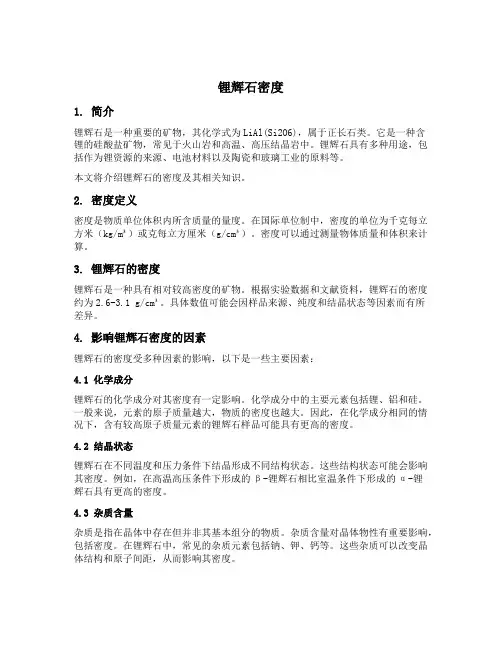
锂辉石密度1. 简介锂辉石是一种重要的矿物,其化学式为LiAl(Si2O6),属于正长石类。
它是一种含锂的硅酸盐矿物,常见于火山岩和高温、高压结晶岩中。
锂辉石具有多种用途,包括作为锂资源的来源、电池材料以及陶瓷和玻璃工业的原料等。
本文将介绍锂辉石的密度及其相关知识。
2. 密度定义密度是物质单位体积内所含质量的量度。
在国际单位制中,密度的单位为千克每立方米(kg/m³)或克每立方厘米(g/cm³)。
密度可以通过测量物体质量和体积来计算。
3. 锂辉石的密度锂辉石是一种具有相对较高密度的矿物。
根据实验数据和文献资料,锂辉石的密度约为2.6-3.1 g/cm³。
具体数值可能会因样品来源、纯度和结晶状态等因素而有所差异。
4. 影响锂辉石密度的因素锂辉石的密度受多种因素的影响,以下是一些主要因素:4.1 化学成分锂辉石的化学成分对其密度有一定影响。
化学成分中的主要元素包括锂、铝和硅。
一般来说,元素的原子质量越大,物质的密度也越大。
因此,在化学成分相同的情况下,含有较高原子质量元素的锂辉石样品可能具有更高的密度。
4.2 结晶状态锂辉石在不同温度和压力条件下结晶形成不同结构状态。
这些结构状态可能会影响其密度。
例如,在高温高压条件下形成的β-锂辉石相比室温条件下形成的α-锂辉石具有更高的密度。
4.3 杂质含量杂质是指在晶体中存在但并非其基本组分的物质。
杂质含量对晶体物性有重要影响,包括密度。
在锂辉石中,常见的杂质元素包括钠、钾、钙等。
这些杂质可以改变晶体结构和原子间距,从而影响其密度。
4.4 结晶质量结晶质量是指晶体的纯度和完整度。
纯度较高、结晶较完整的锂辉石样品通常具有更高的密度。
不同产地和加工方法可能会导致锂辉石样品的结晶质量不同,进而影响其密度。
5. 锂辉石的应用锂辉石作为一种重要的矿物资源,具有广泛的应用前景。
以下是一些主要应用领域:5.1 锂资源锂是一种重要的工业金属,广泛应用于电池、冶金、化工等领域。
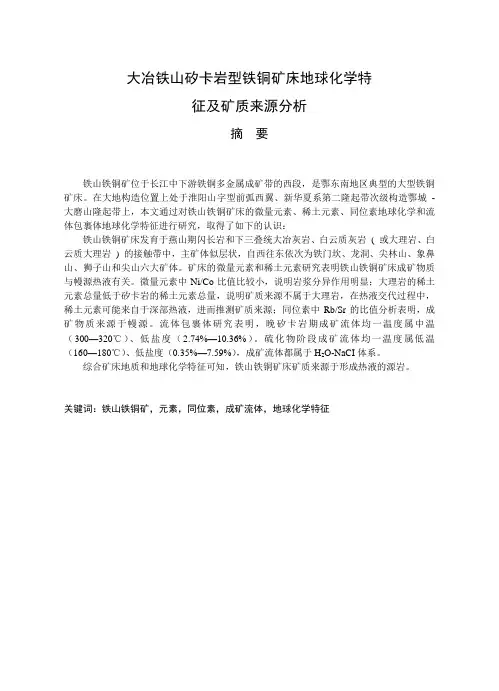
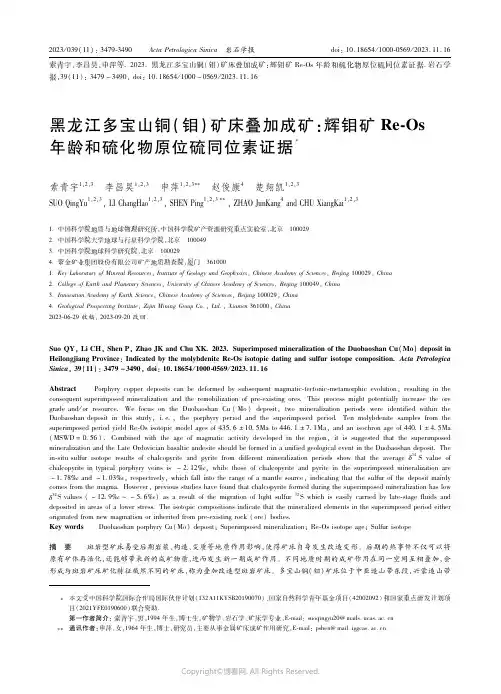
2023/039(11):3479 3490ActaPetrologicaSinica 岩石学报doi:10.18654/1000 0569/2023.11.16索青宇,李昌昊,申萍等.2023.黑龙江多宝山铜(钼)矿床叠加成矿:辉钼矿Re Os年龄和硫化物原位硫同位素证据.岩石学报,39(11):3479-3490,doi:10.18654/1000-0569/2023.11.16黑龙江多宝山铜(钼)矿床叠加成矿:辉钼矿Re Os年龄和硫化物原位硫同位素证据索青宇1,2,3 李昌昊1,2,3 申萍1,2,3 赵俊康4 楚翔凯1,2,3SUOQingYu1,2,3,LIChangHao1,2,3,SHENPing1,2,3 ,ZHAOJunKang4andCHUXiangKai1,2,31 中国科学院地质与地球物理研究所,中国科学院矿产资源研究重点实验室,北京 1000292 中国科学院大学地球与行星科学学院,北京 1000493 中国科学院地球科学研究院,北京 1000294 紫金矿业集团股份有限公司矿产地质勘查院,厦门 3610001 KeyLaboratoryofMineralResources,InstituteofGeologyandGeophysics,ChineseAcademyofSciences,Beijing100029,China2 CollegeofEarthandPlanetarySciences,UniversityofChineseAcademyofSciences,Beijing100049,China3 InnovationAcademyofEarthScience,ChineseAcademyofSciences,Beijing100029,China4 GeologicalProspectingInstitute,ZijinMiningGroupCo ,Ltd ,Xiamen361000,China2023 06 29收稿,2023 09 20改回SuoQY,LiCH,ShenP,ZhaoJKandChuXK 2023 SuperimposedmineralizationoftheDuobaoshanCu(Mo)depositinHeilongjiangProvince:IndicatedbythemolybdeniteRe Osisotopicdatingandsulfurisotopecomposition.ActaPetrologicaSinica,39(11):3479-3490,doi:10.18654/1000 0569/2023.11.16Abstract Porphyrycopperdepositscanbedeformedbysubsequentmagmatic tectonic metamorphicevolution,resultingintheconsequentsuperimposedmineralizationandtheremobilizationofpre existingores Thisprocessmightpotentiallyincreasetheoregradeand/orresource WefocusontheDuobaoshanCu(Mo)deposit,twomineralizationperiodswereidentifiedwithintheDuobaoshandepositinthisstudy,i e ,theporphyryperiodandthesuperimposedperiod TenmolybdenitesamplesfromthesuperimposedperiodyieldRe Osisotopicmodelagesof435 6±10 5Mato446 1±7 1Ma,andanisochronageof440 1±4 5Ma(MSWD=0 56) Combinedwiththeageofmagmaticactivitydevelopedintheregion,itissuggestedthatthesuperimposedmineralizationandtheLateOrdovicianbasalticandesiteshouldbeformedinaunifiedgeologicaleventintheDuobaoshandeposit Thein situsulfurisotoperesultsofchalcopyriteandpyritefromdifferentmineralizationperiodsshowthattheaverageδ34Svalueofchalcopyriteintypicalporphyryveinsis-2 12‰,whilethoseofchalcopyriteandpyriteinthesuperimposedmineralizationare-1 78‰and-1 03‰,respectively,whichfallintotherangeofamantlesource,indicatingthatthesulfurofthedepositmainlycomesfromthemagma However,previousstudieshavefoundthatchalcopyriteformedduringthesuperimposedmineralizationhaslowδ34Svalues(-12 9‰~-5 6‰)asaresultofthemigrationoflightsulfur32Swhichiseasilycarriedbylate stagefluidsanddepositedinareasofalowerstress Theisotopiccompositionsindicatethatthemineralizedelementsinthesuperimposedperiodeitheroriginatedfromnewmagmatismorinheritedfrompre existingrock(ore)bodiesKeywords DuobaoshanporphyryCu(Mo)deposit;Superimposedmineralization;Re Osisotopeage;Sulfurisotope摘 要 斑岩型矿床易受后期岩浆、构造、变质等地质作用影响,使得矿床自身发生改造变形。
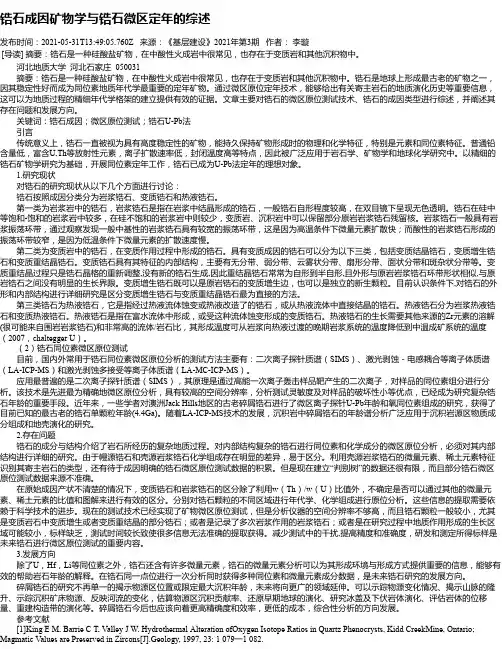
锆石成因矿物学与锆石微区定年的综述发布时间:2021-05-31T13:49:05.760Z 来源:《基层建设》2021年第3期作者:李璇[导读] 摘要:锆石是一种硅酸盐矿物,在中酸性火成岩中很常见,也存在于变质岩和其他沉积物中。
河北地质大学河北石家庄 050031摘要:锆石是一种硅酸盐矿物,在中酸性火成岩中很常见,也存在于变质岩和其他沉积物中。
锆石是地球上形成最古老的矿物之一,因其稳定性好而成为同位素地质年代学最重要的定年矿物。
通过微区原位定年技术,能够给出有关寄主岩石的地质演化历史等重要信息,这可以为地质过程的精细年代学格架的建立提供有效的证据。
文章主要对锆石的微区原位测试技术、锆石的成因类型进行综述,并阐述其存在问题和发展方向。
关键词:锆石成因;微区原位测试;锆石U-Pb法引言传统意义上,锆石一直被视为具有高度稳定性的矿物,能持久保持矿物形成时的物理和化学特征,特别是元素和同位素特征。
普通铅含量低,富含U,Th等放射性元素,离子扩散速率低,封闭温度高等特点,因此被广泛应用于岩石学、矿物学和地球化学研究中。
以精细的锆石矿物学研究为基础,开展同位素定年工作,锆石已成为U-Pb法定年的理想对象。
1.研究现状对锆石的研究现状从以下几个方面进行讨论:锆石按照成因分类分为岩浆锆石、变质锆石和热液锆石。
第一类为岩浆岩中的锆石,岩浆锆石是指在岩浆中结晶形成的锆石,一般锆石自形程度较高,在双目镜下呈现无色透明。
锆石在硅中等饱和-饱和的岩浆岩中较多,在硅不饱和的岩浆岩中则较少,变质岩、沉积岩中可以保留部分原岩岩浆锆石残留核。
岩浆锆石一般具有岩浆振荡环带,通过观察发现一般中基性的岩浆锆石具有较宽的振荡环带,这是因为高温条件下微量元素扩散快;而酸性的岩浆锆石形成的振荡环带较窄,是因为低温条件下微量元素的扩散速度慢。
第二类为变质岩中的锆石,在变质作用过程中形成的锆石。
具有变质成因的锆石可以分为以下三类,包括变质结晶锆石,变质增生锆石和变质重结晶锆石。

专利名称:QUANTITATIVE ANALYSIS OF COPPER IN MATERIAL MAINLY COMPOSED OF ZINCOXIDE发明人:SATOU MASUMI申请号:JP6084984申请日:19840330公开号:JPS60205238A公开日:19851016专利内容由知识产权出版社提供摘要:PURPOSE:To elevate the accuracy of quantitative analysis by coinciding acid concentrations of a sample solution which is prepared by adding boronic acid to material dissolved in hydrochloric acid and hydrofluoric acid with a solution for calibration curve to measure the absorbance thereof at the wavelength of 324.8nm with an atomic absorptiometer separately, which are compared to the calibration curve. CONSTITUTION:Acid concentrations are coincided of a sample solution which is prepared by adding boric acid to material dissolved in hydrochloric acid and hydrofluoric acid with a solution for calibration curve to remove the effect thereof while both the solutions are put on an atomic absorptiometer separately to measure the absorbance thereof at the wavelength of 324.8nm. Then, the integrated values of the absorbances are used as measured value and compared to the calibration curve prepared by measuring the solution for calibration curve to determine the concentration of copper. Thus, the quantitative analysis of trace of copper can be done at a high accuracy employing the atomic absorptiometer.申请人:MEIDENSHA KK更多信息请下载全文后查看。
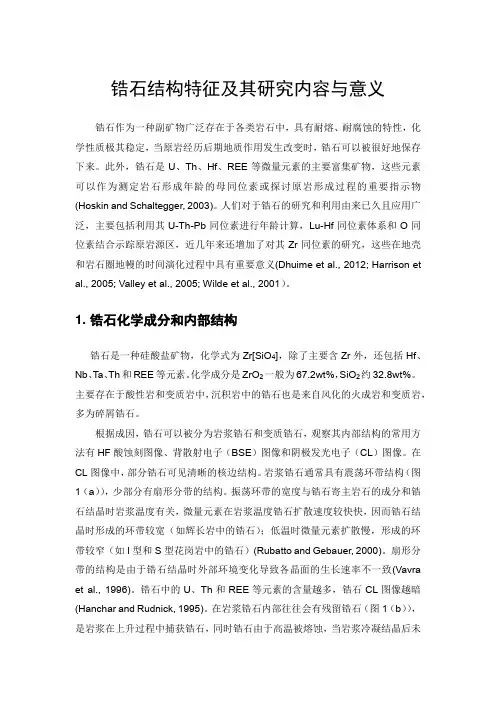
锆石结构特征及其研究内容与意义锆石作为一种副矿物广泛存在于各类岩石中,具有耐熔、耐腐蚀的特性,化学性质极其稳定,当原岩经历后期地质作用发生改变时,锆石可以被很好地保存下来。
此外,锆石是U、Th、Hf、REE等微量元素的主要富集矿物,这些元素可以作为测定岩石形成年龄的母同位素或探讨原岩形成过程的重要指示物(Hoskin and Schaltegger, 2003)。
人们对于锆石的研究和利用由来已久且应用广泛,主要包括利用其U-Th-Pb同位素进行年龄计算,Lu-Hf同位素体系和O同位素结合示踪原岩源区,近几年来还增加了对其Zr同位素的研究,这些在地壳和岩石圈地幔的时间演化过程中具有重要意义(Dhuime et al., 2012; Harrison et al., 2005; Valley et al., 2005; Wilde et al., 2001)。
1. 锆石化学成分和内部结构锆石是一种硅酸盐矿物,化学式为Zr[SiO4],除了主要含Zr外,还包括Hf、Nb、Ta、Th和REE等元素。
化学成分是ZrO2一般为67.2wt%,SiO2约32.8wt%。
主要存在于酸性岩和变质岩中,沉积岩中的锆石也是来自风化的火成岩和变质岩,多为碎屑锆石。
根据成因,锆石可以被分为岩浆锆石和变质锆石,观察其内部结构的常用方法有HF酸蚀刻图像、背散射电子(BSE)图像和阴极发光电子(CL)图像。
在CL图像中,部分锆石可见清晰的核边结构。
岩浆锆石通常具有震荡环带结构(图1(a)),少部分有扇形分带的结构。
振荡环带的宽度与锆石寄主岩石的成分和锆石结晶时岩浆温度有关,微量元素在岩浆温度锆石扩散速度较快快,因而锆石结晶时形成的环带较宽(如辉长岩中的锆石);低温时微量元素扩散慢,形成的环带较窄(如I型和S型花岗岩中的锆石)(Rubatto and Gebauer, 2000)。
扇形分带的结构是由于锆石结晶时外部环境变化导致各晶面的生长速率不一致(Vavra et al., 1996)。
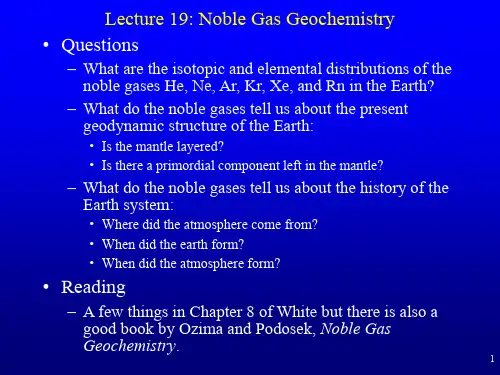
赞比亚铜带省铜矿成因分析刘俊辰;莫江平;刘草【摘要】中非(赞比亚―刚果(金))沉积型铜矿以其拥有高品位的大型超大型铜、钴矿床和众多的世界级铜矿山而闻名于世。
铜矿类型可分为沉积型铜矿、热液脉型铜矿、变质热液型铜矿三类。
沉积型铜矿床形成后,受到深部含矿岩浆热液的侵入形成脉状铜矿,可能还有斑岩型铜钼矿的成矿作用,叠加富集原有的沉积型铜矿床。
硫同位素结果显示,硫源主要为成岩硫化物和海水硫酸盐的混合硫,受到深源岩浆或岩浆热液叠加改造。
沉积型铜矿成矿年龄880~735Ma,后期岩浆热液型铜钼矿成矿年龄为514~502Ma。
这些发现对进一步认识总结中非铜矿带上的矿床成因及成矿规律具有重要意义。
%The sedimentary copper deposits in Central Africa (Zambia-D.R.Congo)are renowned for the high-grade super-large copper and cobalt deposits and numerous world-class copper mines.The types of copper deposits include sedimentary type,hydrothermal vein type and metamorphic hydrothermal type.After its formation,sedimentary copper deposit forms vein type copper deposit under the influence of intrusion of ore-bearing magmatic hydrothermal solution in deep part.The original sedimentary copper deposit is super-imposed and enriched through the possible ore-forming process of porphyry type copper-molybdenum deposit. The sulfur isotope indicates that the sulfur source,which is mainly mixed sulfur of diagenetic sulfide and seawater sulfate,is superimposed and transformed by deep-seated magma or magmatic hydrothermal solu-tion.The metallogenic age of sedimentary type copper deposits ranges from 880 to 735 Ma,and that of mag-matic hydrothermal-type coppercobalt deposits ranges from 5 14 to 502 Ma.The findings have important implications for further understanding of genesis and metallogenic regularity of deposits in Central Africa copper ore belt.【期刊名称】《矿产与地质》【年(卷),期】2016(030)002【总页数】5页(P203-207)【关键词】铜矿;沉积成因;岩浆热液成因;赞比亚铜带省【作者】刘俊辰;莫江平;刘草【作者单位】桂林理工大学,广西桂林 541004;桂林理工大学,广西桂林541004; 中国有色桂林矿产地质研究院有限公司,广西桂林 541004;桂林理工大学,广西桂林 541004【正文语种】中文【中图分类】P618.41赞比亚铜带省铜矿位于世界著名的赞比亚―刚果(金)铜(钴)成矿带东部,该成矿带因其丰富的铜矿资源而闻名,成矿带上铜的储量占世界总储量的25%,仅次于南美洲安第斯山脉(智利、秘鲁、阿根廷)和北美洲美国西部―墨西哥两个铜矿带,成矿带纵贯赞比亚西北省和铜带省,多数的沉积型矿床都位于铜带省中。
第49卷 第6期Vol.49, No.6, 637–6522020年11月GEOCHIMICANov., 2020收稿日期(Received): 2019-03-05; 改回日期(Revised): 2019-03-29; 接受日期(Accepted): 2019-04-10 基金项目: 国家重点研发计划(2016YFC0600204); 中国地质调查局整装勘查项目(12120114034701) 作者简介: 张三衡(1992–), 男, 硕士研究生, 地球化学专业。
E-mail:********************** 通讯作者(Corresponding author):LIWu-xian,E-mail:***********.cn;Tel:+86-20-85290225Geochimica ▌ Vol. 49 ▌ No. 6 ▌ pp. 637–652▌ Nov., 2020江西武山铜矿黑云母的化学成分特征:地质与成矿意义张三衡1,2, 李武显1*, 周贤旭3, 杨东生4, 吕璞良5(1. 中国科学院 广州地球化学研究所 同位素地球化学国家重点实验室, 广东 广州 510640; 2. 中国科学院大学, 北京 100049; 3. 江西省 地质矿产勘查开发局 赣西北大队, 江西 九江 332000; 4. 中国科学院 广州地球化学研究所 矿物学与成矿学重点实验室, 广东 广州 510640; 5. 南宁师范大学 北部湾环境演变与资源利用教育部重点实验室, 南宁 530001)摘 要: 华南燕山期岩浆活动频繁, 出露有大量的斑岩侵入体, 形成了许多与斑岩侵入体有关的铜多金属矿床。
对九瑞矿集区与铜矿有关的武山岩体黑云母矿物进行了详细的镜下观察和电子探针分析。
依据镜下岩相学特征可以将研究的黑云母分为斑晶黑云母和基质黑云母两类, 两类黑云母成分上均为镁质黑云母, 并且大部分斑晶黑云母受到热液蚀变的影响, 已经具有蚀变黑云母的特征。
xxxxxxxxxxxxxxxxxxxxxxxxxxxxxx xx本科毕业论文外文资料翻译系别: xxx专业: xxx姓名: xxx学号: xxx1 区域成矿背景概述塔木铅锌矿床位于阿克陶县塔木村北约5 km,大地构造位置为西昆仑造山带与塔里木板块的交接部位[1],属库斯拉甫-他龙铅锌(铜)成矿带的一部分。
本区前震旦纪末期陆壳裂解形成塔里木板块、西昆仑地体、帕米尔板块等。
加里东期塔里木板块沿库地北断裂(俯冲带)往南西向西昆仑地体俯冲,形成昆中岩浆弧;两者于志留纪末期拼贴为一体[2]。
加里东期花岗质岩浆侵入时代的变化趋势佐证了这一观点[3]。
晚古生代时受古特提斯裂解作用的影响,俯冲带迁移到康西瓦断裂带附近,板块俯冲方向由南西往北东,西昆仑中带成为晚古生代岩浆弧(即昆中多期岩浆弧)[4],库斯拉甫-他龙地区正处于弧后位置,在板块俯冲的影响下发展为晚古生代弧后裂谷(即奥依塔格-库尔良裂陷槽)。
随着古特提斯洋的消亡,库斯拉甫-他龙晚古生代裂谷盆地于二叠纪末期闭合。
三叠纪时期本区处于隆起剥蚀状态,缺失沉积。
侏罗纪为山间盆地相与间夹沼泽相沉积。
至白垩纪末与早第三纪早期,因受新特提斯裂谷化作用遭受一次海侵,形成一套浅海至湖相的沉积岩系。
在喜马拉雅期造山运动的作用下,新特提斯洋闭合,青藏高原崛起,盆山构造急剧分野,引起本区西昆仑前缘大规模的逆冲推覆和走滑,形成铁克力克推覆体等构造,奠定了现今的构造格局。
因此,库斯拉甫-他龙铅锌(铜)成矿带所处的大地构造位置为晚古生代弧后裂谷盆地)))具陆壳基底的奥依塔格-库尔良裂陷槽,晚古生代的裂谷沉积作用、海西末期和喜马拉雅期的强烈构造作用为本区大范围、高强度的铅锌(铜)成矿创造了有利的构造条件[5]。
塔木MVT型铅锌矿区及外围主要出露上泥盆统、石炭系、侏罗系与白垩系)第三系地层,褶皱构造为科克然达坂复式向斜东翼的塔木向斜,区域断裂有克孜勒陶-库斯拉甫北北西向走滑断裂系与北西向昆北逆冲推覆断裂系。
西藏多不杂铜矿床锶、钕、铪同位素特征及其地质意义何阳阳;温春齐;刘显凡【摘要】探讨西藏自治区改则县多不杂铜矿床的成矿物质来源及成矿动力学原理.选择矿区内花岗闪长斑岩全岩、黄铁矿以及锆石样品,测试锶、钕、铪同位素组成.结果显示,多不杂铜矿床样品中的Sr初始值介于幔源镁铁质岩石 Sr 同位素的平均值和壳源硅铝质岩石 Sr 同位素的平均值之间,靠近幔源镁铁质岩石,暗示花岗闪长斑岩的原始岩浆起源于地幔,在上升侵位时与硅铝质地壳物质发生交换,使其具有壳幔混染特征;花岗闪长斑岩具有相对高(87Sr/86Sr)i、低143Nd/144Nd的特征是交代富集地幔的反映,锶同位素的迁移行为与成矿元素相似,携带含矿物质的流体由斑岩体向围岩进行了迁移,并与围岩之间发生充填交代,导致变质砂岩含矿;锆石εHf(t)值基本为正值,且变化范围较大,是有较多幔源组分参与成岩的标志,指示幔源岩浆作用过程中伴有地壳流体的混染.矿床成因综合研究初步揭示多不杂铜矿床是由地幔流体作用引发壳幔物质混染叠加成矿.%The Sr,Nd and Hf isotopic compositions from the granodiorite porphyry rocks,pyrite and zircon samples in Duobuza copper deposit of Tibet are studied so as to discuss the sources of ore-forming materials and dynamic principle of the Duobuza copper deposit.It shows that the initial Sr values of the Duobuza copper deposit is in the average value range of mantle derived mafic rock and values of crust derived siliceous and aluminous rocks,and close to the parameter of mantle derived mafic rocks,suggesting that the primitive magma of granodiorite porphyry is originated from the mantle.In the process of magmatic emplacement,the mantle derived magma is exchange with crustal material of silica alumina and lead to the appearance ofmantle crust mixation characteristics.The features of relatively high (87Sr/86Sr)iand low 143Nd/144Nd in the granodiorite porphyry is resulted from the metasomatic enrichment in the mantle.The migration of strontium isotope is similar to that of ore-forming elements,and the metal ore-forming elements in the solution are moved from porphyry body to the wallrocks.In the migration process filling and metasomatism occur and the metamorphic sandstone becomes ore-bearing rock.TheεHf(t)values of zircon is basically positive and varied in a large range,as result of the addition of mantle material in the formation of rock,and from fluid contamination of mantle and crust.The comprehensive study of the ore deposit genesis reveals that the mantle fluid effect leads to crust-mantle hybridism and to the formation of superimposed mineralization.【期刊名称】《成都理工大学学报(自然科学版)》【年(卷),期】2018(045)004【总页数】10页(P449-458)【关键词】铷锶同位素;钐钕同位素;镥铪同位素;多不杂;西藏【作者】何阳阳;温春齐;刘显凡【作者单位】内江师范学院地理与资源科学学院,四川内江 641112;成都理工大学地球科学学院,成都 610059;成都理工大学地球科学学院,成都 610059;成都理工大学地球科学学院,成都 610059【正文语种】中文【中图分类】P618.41;P597多不杂铜矿床所处位置隶属于西藏改则县,据西藏地调院报告,该矿床目前提交的铜、金资源储量均已达到超大型规模[1]。
英文地质书刊中常用词组Aa bit of 一点,少量的above all 尤其是,最重要的是according as 依照,随。
而定according to 依照,根据account for 说明,解释act as 起。
作用,担任act(up)on对。
起作用a few 有几个,有一些after all 毕竟,终究a good(great)deal of 很多a good(great)many of 很多agree to 答应,承认agree with 同意。
的意见,与。
一致a little 一点;一会儿all at once 突然all but差不多,几乎,都all over 到处;完全;结束all over the world全世界all the same完全一样,依然all the time始终,一直all the while始终,一直all through从头到尾,始终along with与。
一道;随着a lot of大量,许多amount to总计,等于and so forth等等and so on等等and the like等等answer to符合,与。
一致a number of若干apart from 除。
外,且不说as a matter of course当然的事as a matter of fact 实际上,其实as a result结果as a result of由于。
结果as a rule通常as a whole整个说来as concerns至于,关于as early as 早在a series of一系列as far as远至,到。
程度;尽。
所as far as。
be concered就。
而论,对。
来说as far as。
goes就。
而论as far back as早在。
(就),远在。
(就)as follows 如下,如下所述as for至于,就。
而论as good as和。
Copper isotope ratios in magmatic and hydrothermalore-forming environmentsPeter rson *,Kierran Maher,Frank C.Ramos,Zhaoshan Chang,Miguel Gaspar,Lawrence D.MeinertDepartment of Geology,Washington State University,Pullman,WA 99164-2812USAAccepted 7August 2003AbstractMulti-collector inductively coupled plasma mass spectrometry nowaccurate measurements of Cu isotope ratios.Copper minerals prepared by direct dissolution with and without purification yield identical Cu isotope ratios within analytic precision of about 0.04x (1r ).Cu isotope ratios have been measured for copper minerals from worldwide magmatic and hydrothermal copper deposits,and for several weathered deposits.Natural variations in d 65Cu values,relative to NBS976,range over 9x .Chalcopyrite samples from mafic intrusions lie within a narrow range of about 1.5x ,and most cluster tightly between À0.10x and À0.20x .This range lies within the broader black smoker chalcopyrite and iron meteorite ranges,and possibly represents a bulk mantle Cu isotope ratio.Most values for hydrothermal native copper from the Michigan native copper district also show a narrow range just larger than 0.1x and suggest a common homogeneous source for Cu in this large hydrothermal ter copper sulfide and arsenide minerals from this district range to values more than 2x lower than native copper.Ratios for chalcopyrite and bornite from moderate to high-temperature porphyry,skarn,and replacement deposits as a group and within individual deposits exhibit a broad range of values.Variations of nearly 1x are observed over distances on the order of 1m.In some cases,these variations may result from multiple mineralization events or copper remobilization during retrograde or later hydrothermal activity.Fractionations between chalcopyrite and bornite,where they occur in the same sample or in related samples,cluster near 0.4x ,suggesting equilibrium Cu isotope fractionation between them at moderate temperatures.In addition,weathering of hydrothermal copper minerals produces a wide range of values in secondary copper phases.In the supergene environment,cuprite typically has higher values than associated native copper.Therefore,redox states appear to exert a significant control over fractionation at low temperatures.Significant questions remain to be answered.Before the source of copper in hydrothermal environments can be fully addressed,source reservoir Cu ratios need to be determined,and chemical and physical factors that control Cu isotope fractionation must be quantitatively defined.D 2003Elsevier B.V .All rights reserved.Keywords:Cu;Isotope geochemistry;Hydrothermal;Mass fractionation1.IntroductionNatural variations in transition metal stable isotopesare now known to be widespread.Isotope ratios for Cr (Ellis et al.,2002),Fe (Beard and Johnson,1999;0009-2541/$-see front matter D 2003Elsevier B.V .All rights reserved.doi:10.1016/j.chemgeo.2003.08.006*Corresponding author.Tel.:+1-509-335-3095.E-mail address:plarson@ (rson)./locate/chemgeoChemical Geology 201(2003)337–350赤铜矿Anbar et al.,2000;Bullen et al.,2001),and Cu (Mare´chal et al.,1999;Zhu et al.,2000)range over several per mil.Variations in the isotope ratios for transition metals may be produced by either abiotic or biotic processes(Bullen et al.,2001).Mass-dependent abiotic fractionations are predicted by molecular vi-bration theory,where heavier isotopes are preferential-ly partitioned into more tightly bonded sites in minerals and aqueous species(Bigeleisen and Mayer, 1947;Urey,1947).Biotic fractionation is produced when microbial activity selectively uses lighter iso-topes to maximize free energy.The magnitudes and relative importance of abiotic and biotic fractionations for transition metal isotopes in earth systems are not well known,nor are their functional dependencies on temperature or other parameters such as redox states.Modern advances in multi-collector inductively coupled plasma mass spectrometry(MC-ICPMS) now allow for precise and accurate measurement of transition metal isotope ratios.This has generated a renewed research interest in transition metal isotopes. Walker et al.(1958)and Shields et al.(1965)first used thermal ionization mass spectrometry(TIMS)to in-vestigate the distribution of Cu isotopes in natural samples.They found a range of about12x among both hypogene(primary hydrothermal)and supergene (secondary weathering)Cu ore minerals,although their analytical precision was about1.5x.Precision of Cu ratios measured by MC-ICPMS are typically 0.03–0.04x(1r)for both Zn doping and sample–standard bracketing techniques(Mare´chal et al.,1999; Zhu et al.,2000;Mare´chal and Albare`de,2002). Equilibrium mass-dependent abiotic Cu isotope frac-tionations should decrease with increasing tempera-ture,and,at high hydrothermal and magmatic temperatures(>300j C),equilibrium fractionations are most likely small.Therefore,highly precise meas-urements are required if such small variations among Cu mineral ratios are to be investigated.Cu mineral ratios measured by MC-ICPMS instruments have recently been published(Mare´chal et al.,1999;Zhu et al.,2000),and,together with the data reported here, show a range in d65Cu values(relative to NBS976)of more than9x,comparable to the range in early data reported by Walker et al.(1958)and Shields et al. (1965).Transition metal isotope ratios can provide insight into some longstanding questions associated with hy-drothermal systems.A specific focus of our research explores one such question:what are the sources of metals,in this case Cu,in ore-bearing hydrothermal deposits?There are two significant aspects of this problem.First,are metals derived from magmatic sources or are they leached from wall rocks?Hydro-thermal fluids in porphyry Cu deposits are known,for example,to be derived from two sources.Oxygen and hydrogen isotope analyses of hydrothermal minerals have shown that magmatic fluids dominate the central parts of these systems and that meteoric ground waters can be important in their exterior(Sheppard et al., 1969,1971;Larson,1987;Larson and Taylor,1986; Taylor,1997).Although many workers agree that most, if not all,of the Cu in these systems is contributed by the magma(e.g.,Gustafson and Hunt,1975),the porphyry environment demonstrates that multiple fluid sources could potentially provide distinct sources of Cu to some hydrothermal systems.Second,since Cu in a magma is inherited from the magmatic source(e.g., mantle,crustal,and/or subducted slab),Cu isotope ratios in magmatically derived copper deposits may help to distinguish Cu contributions to such magmas if those sources can be shown to be isotopically distinct. Farmer and DePaolo(1997)have used heavy radio-genic isotope ratios(Sr,Nd,and Pb)in hydrothermal systems to address this question.Their results are interpreted to show that hydrothermal components indeed can be traced back to magmatic sources.We report our first results for Cu isotope ratio measurements on Cu minerals from ore deposits. These data,together with other published Cu isotope ratios on ore minerals,can be used to evaluate the sources of Cu in hydrothermal ore deposits.However, there are many questions that need to be addressed before such data can be fully applied to assessing copper sources in hydrothermal environments.First, how precisely can MC-ICPMS measure Cu isotope ratios and do such ratios appear to vary in any systematic way?Second,the Cu ratios of potential source reservoirs are generally unknown or not well constrained,thus,they need to be characterized.And third,mechanisms that control Cu isotope fraction-ation,such as redox reactions and equilibrium thermo-dynamic fractionations among solids or dissolved aqueous species,and their temperature dependencies, must be known but are only beginning to be experi-mentally investigated.Here,we show that systematicrson et al./Chemical Geology201(2003)337–350 338variations in Cu ratios exist in hydrothermal depositsand report preliminary data on Cu ratio characteristicsof common terrestrial reservoirs.2.Analytical methodologyMC-ICPMS now allows for high-precision isotopeanalysis of Cu,an element which is not normallymeasured by more established techniques(e.g.,TIMS)as a result of its poor ionization efficiency(Walker etal.,1958;Shields et al.,1965).MC-ICPMS overcomessuch limitations by injecting Cu into an argon plasmawhile using multiple collectors to simultaneously mea-sure63Cu and65Cu.In doing so,MC-ICPMS has beenthe catalyst for a resurgence of interest in the field ofCu isotope geochemistry.Initial MC-ICPMS applica-tions(Mare´chal et al.,1999;Zhu et al.,2000)confirmthat naturally occurring Cu isotope fractionations areobserved.Such natural fractionations are,however,limited and require that65Cu/63Cu measurements beboth highly precise and highly reproducible.In an effort to obtain these critical characteristics,two methods of analysis have been pursued.The firstutilizes zinc isotopes(68Zn/64Zn)to constrain andcorrect65Cu/63Cu measurements for mass bias as iscustomary for analyses undertaken by MC-ICPMS(Mare´chal et al.,1999;Mare´chal and Albare`de,2002).Alternatively,a sequence of analyses can beundertaken which brackets a natural sample withanalyses of standards(Zhu et al.,2000)as is custom-arily done for light stable isotopes such as hydrogenand oxygen.Both methods have advantages and draw-backs.When using68Zn/64Zn to correct65Cu/63Cu formass bias,the potential isotopically variable natural Znof a sample must be removed and Zn with a known 68Zn/64Zn must be introduced prior to analysis.This process is essential because natural Zn may not havethe same68Zn/64Zn ratio as the known Zn introducedto the sample.Mixing these two variable Zn isotopereservoirs alters the known68Zn/64Zn normalizingratio and results in inaccurate mass bias correctionsfor Cu isotopes.Typically,Zn is removed from sam-ples using chromatography.Chromatography,howev-er,must be well calibrated and monitored because it canalso fractionate65Cu from63Cu(Mare´chal et al.,1999;Mare´chal and Albare`de,2002).If,however,natural Zncan be successfully removed without fractionating 65Cu/63Cu,normalizing to a known68Zn/64Zn ratio should reasonably correct for mass bias,assumingmass bias is completely a function of mass.In additionto mass bias,isotopic variations resulting from machinedrift(i.e.,variations occurring in the plasma,tempera-ture variations,electronic variations,etc.)will alsoaffect Zn isotopes,and,thus,can be accounted for inthe68Zn/64Zn normalizing process.In contrast,sample–standard bracketing does notrequire either introduction of known Zn or removal ofnatural Zn in a sample.Thus,chromatography is onlyrequired for samples that contain molecular or isobaricinterferences that cannot be successfully stripped fromthe measured results,or that cause matrix effects whichsignificantly impact measured ratios.Sample–stan-dard bracketing,however,may not readily accountfor machine drift,as exemplified by large,non-con-sistent fluctuations in standard values,and,therefore,is best used on machines that either have constant ornegligible drift.The Finnigan Neptune R in the GeoAnalytical Lab-oratory at Washington State University is a newlydesigned MC-ICPMS.It allows for high-precisionmeasurements of both stable and radiogenic isotopeswith minimal instability and machine drift.We haveundertaken an extensive evaluation to constrain theaccuracy and reproducibility of65Cu/63Cu measure-ments on this machine using Cu minerals from a varietyof environments.We have utilized sample–standardbracketing(independent of Zn)to constrain and correct 65Cu/63Cu for mass bias and machine drift.As is critical for sample–standard bracketing,machine drift must beconstant(or absent)to ensure the highest in-run preci-sion and external reproducibility of results(an exampleof a single day’s run is shown in Fig.1).The criticalaspect of these variations is that machine drift of theNeptune is constant(or absent)within analytical un-certainty and can be accurately assessed and correctedfor using bracketed NBS976analyses(note that ourmeasured value for NBS976varies with date,but suchvariations are eliminated during standard normaliza-tion).A line fit to the first NBS976standard suite,April24,2002,reflects0.16x drift over a period of greaterthan8h.The run on June4,2002(Fig.1)shows evenless drift.Drift is relatively constant over this periodand allows for samples to be very accurately correctedfor both machine drift and mass bias.In fact,select daysare characterized by an apparent absence of machinerson et al./Chemical Geology201(2003)337–350339drift over a period of 12h.As a result,sample–standard analyses on the Neptune can successfully measure 65Cu/63Cu independent of Zn.Prior to analysis,Cu minerals were carefully hand-picked and visually inspected to ensure purity.Miner-als were first dissolved in distilled aqua regia for at least 3days.These solutions were then evaporated to dryness and their residual were redissolved in 2%nitric acid and diluted to about 100ppb Cu.Cu ratios are reported in d notation in per mil relative to NBS976(63Cu/65Cu =2.24F 0.0021)which is prepared identi-cally to unknown minerals and used as an operating standard.Each analysis consists of 50isotope ratio measurements of 8s each (Fig.1).The d values are calculated using mean ratios for each block of 50measurements (Fig.2),whered 65Cu NBS976¼½ðR SMP =R STD ÞÀ1 1000:ð1ÞR SMP is the ratio 65Cu/63Cu for the unknown sample,and R STD is the ratio 65Cu/63Cu for the standard.R STD is calculated as the mean 65Cu/63Cu ratio of the two blocks of measurements that bracket each unknown sample (Fig.2).d 65Cu NBS976values,measured using the sample–standard bracketing technique,arere-Fig.1.Data acquired during the mass spectrometer run on June 4,2002.Measured 65Cu/63Cu ratios are plotted vs.real time.Each cluster comprises 50measurements of 8s each for an analysis.The box encloses a standard –sample–standard bracket reproduced in Fig.2.Fig.2.65Cu/63Cu ratios for three blocks of measurements enlarged from Fig.1.This shows one standard (black diamonds)–sample (gray circles)–standard bracket from which a Cu d 65Cu value is calculated.R SMP and R STD are mean ratios that are input into Eq.(1)in the text to calculate the delta value.R STD is determined by fitting a line to the two bracketing standard means.Each cluster represents 50measurements,each of 8s duration.Table 1Cu-isotope composition of chalcopyrite from mafic intrusions Sample Description d 65Cu aTL-4Thayer–Lindsley Mine,Sudbury;Canada,sulfide matrix of impact brecciaÀ0.25Sd-5Sudbury;Massive sulfide from base of Sudbury Intrusive Complex,Canada0.16SW-22Stillwater Mine,USA;hydrothermally reworked sulfides at contact of Stillwater igneous complex À1.06aAll data are per mil relative to NBS976,analytic uncertainty is F 0.04x (1r ).P rson et al./Chemical Geology 201(2003)337–350340ported for chalcopyrite from mafic igneous rocks (Table 1),for copper minerals from the Michigan Native Copper District,USA (Table 2),for chalcopyrite and bornite from various worldwide skarn,porphyry,and replacement deposits (Tables 3and 4),and for supergene copper minerals from oxidizing and weath-ering hypogene hydrothermal minerals from a variety of deposits (Table 5).Table 2Cu isotope composition of Cu minerals from the Michigan native copper district,USA Sample Location Minerald 65Cu a Mean and 1r d 65CuLS-7Trimountain Mine Native Cu 0.270.27LS-10Baltic Mine Native Cu0.36,0.30,0.27,0.30,0.29,0.27,0.22,0.340.29F 0.04LS-12Centennial Mine Native Cu 0.260.26LS-45Isle Royale Mine Native Cu 0.340.34LS-48Wolverine Mine Native Cu 0.300.30LS-51Copper Falls MineNative Cu0.03,0.010.02F 0.01Mi-6Baltic Mine BorniteÀ1.07À1.07Mi-10Baltic Mine Chalcopyrite À0.71À0.71PL-1Baltic Mine Chalcocite 0.740.74LS-8Mohawk Mine Mohawkite 0.240.24LS-46Mohawk Mine Mohawkite À0.28À0.28Mi-2Mohawk MineDomeykite À0.17À0.17aAll data are per mil relative to NBS976,analytic uncertainty is F 0.04x (1r ).Table 3Cu isotope composition of Cu minerals from porphyry and skarn deposits,Tintaya and Las Bambas districts,Peru SampleMinerald 65Cu aMean and 1r d 65Cu Tajo Tintaya deposit,TintayaTajo Chalcopyrite À0.05À0.05TAJO-MS Chalcopyrite0.540.54Bornite 0.110.11Coroccohuayco deposit,Tintaya 90014.8388.7Chalcopyrite0.000.00BorniteÀ0.46À0.46140015.8163.4Chalcopyrite 0.310.31140018.9301.95Chalcopyrite 0.070.07140018.9386.4Chalcopyrite0.69,0.64b 0.67F 0.04Bornite0.310.31140018.9387.9Chalcopyrite 0.320.32140021.7119.95Chalcopyrite 0.520.52140021.7416.95Chalcopyrite 0.270.27Chalcobamba deposit,Las Bambas Chalc Chalcopyrite 0.370.37CHALC-MAGN1Chalcopyrite 0.170.17Ferrobamba deposit,Las Bambas Ferrob Chalcopyrite0.120.12Bornite0.010.01aAll data are per mil relative to NBS976,analytic uncertainty is F 0.04x (1r ).bReplicate dissolution using only HNO 3.Table 4Cu isotope composition of Cu minerals from other porphyry,skarn,and replacement deposits SampleMinerald 65Cu aMean and 1r d 65Cu Superior Mine,Superior district,Arizona,USA SUP-1Chalcopyrite 0.51,0.52,0.54,0.57,0.54,0.560.54F 0.01Resolution project,Superior district,Arizona,USA RES-2A 1885.55Chalcopyrite 0.060.06RES-2A 1927Chalcopyrite 0.030.03S22-A 969Chalcopyrite 0.530.53S27-A 1847Bornite0.400.40Beaver-Harrison Mine,Beaver County,Utah,USA BEA V Chalcopyrite 1.36,1.41 1.39F 0.04Bornite 1.00 1.00Pine Creek,California,USAPC9Chalcopyrite À0.87,À0.79,À0.75À0.80F 0.06Empire Mine,Idaho,USA18-365I Chalcopyrite À0.66,À0.76,À0.72À0.71F 0.0518-365II Chalcopyrite À0.56,À0.63À0.60F 0.0517-389Chalcopyrite À0.20À0.20Crown Jewel deposit,Washington,USA GAC-12PO Chalcopyrite À0.01,À0.07À0.04F 0.04GAC-12BDChalcopyrite 0.130.13Grasberg deposit,Ertsberg district,Irian Jaya G6Chalcopyrite À0.39À0.39Big Gossan deposit,Ertsberg district,Irian Jaya BG-1-6-600Chalcopyrite 0.230.23aAll data are per mil relative to NBS976,analytic uncertainty is F 0.04x (1r ).P rson et al./Chemical Geology 201(2003)337–350341In addition to constraining machine drift,results illustrate daily and monthly reproducibility of 65Cu/63Cu.External reproducibility has been evaluated using replicate analyses of two native copper samples,Ray-1(10analyses,Table 5)and LS-10(8analyses,Table 2),run over about a 2-month time span.Means of the replicate analyses are À0.04x and 0.29x ,respec-tively,with standard deviations (1r )of 0.04x for both samples.We have also analyzed two samples purified using anion exchange chromatography (modified fromMare´chal et al.,1999).Results from chalcopyrite (GAC 12PO)have confirmed the absence of both Fe and S in the chromatographically prepared Cu sample,and are well within analytical reproducibility (<0.04x )of non-purified samples.Two analyses of the unpurified sample,run on the same solution,yielded values of À0.01x and À0.07x .Chro-matographically purified Cu from the sample pro-duced a value of À0.03x .Additionally,NBS976copper was chromatographically purified,and yielded a value of 0.05x .Together,these results suggest that the chemical preparation procedures do not result in Cu isotope fractionation,at least for one chalcopyrite sample.Matrix effects resulting from Fe and S on Cu isotope ratios have been evaluated,since both are major con-stituents in chalcopyrite and bornite.100ppb NBS976solutions were doped with Fe and S,at 1and 9ppm,respectively,and analyzed.Neither Fe nor S at these concentrations had any apparent effect on the Cu isotope ratio of the standard,within analytical error.It is important to note that these Fe and S concentrations are much higher (>10times)than would be expected from any diluted copper mineral sample.Also,both native copper and chalcopyrite samples have been doped with Pb.10ppb,100ppb,and 1ppm Pb were added to solutions of native copper sample Ray-1(À0.04x ,n =10,1r =0.04x ),and yielded results of À0.07x ,À0.02x ,and 0.08x ,respectively.10ppb,100ppb,and 1ppm Pb were also added to chalcopyrite sample SUP-1(0.54x ,n =6,1r =0.01x ),and yielded results of 0.57x for both the 10and 100ppb solutions,and 0.61x for the 1ppm solution.These Pb-doping experiments suggest that heavy metal concentrations in the solutions produce negligible matrix effects.3.ResultsSamples from a variety of ore deposit types encom-pass a range in depositional environments and poten-tial Cu sources.Cu isotope ratios for all analyses(Tables 1–5;Mare´chal et al.,1999;Zhu et al.,2000;Luck et al.,2002)vary over a range of about 9x in natural samples,although,with the exception of sev-eral high and low samples,most analyses fall within a range of about 4.0x from À1.5to 2.5.This range shows clearly that Cu isotope fractionation is im-portant in nature.Samples include chalcopyrite from mafic igneous rocks (Table 1),and primary hypo-gene hydrothermal (Tables 2–4)and secondary supergene (Table 5)Cu ore minerals.These data,together with data recently published by Mare´chal et al.(1999);Zhu et al.(2000),and Luck et al.(2002),provide a preliminary basis in which to evaluate the Cu isotope ratios in mafic rocks and perhaps the mantle,add insight into the source of Cu in hydrothermal ore-forming systems,and lead to an assessment of chemical factors that most likely control Cu isotope fractionation in natural environments.Table 5Cu isotope composition of Cu minerals supergene environments in ore deposits SampleMinerald 65Cu aMean and 1r y 65CuRay Mine,Arizona,USA Ray-1Native Cu0.02,0.00,À0.05,À0.06,À0.08,À0.09,0.02,b À0.04,b 0.00,b À0.09b À0.04F 0.04Ray-2Native Cuwith cuprite 1.26 1.26Ray-2bNative Cu without cuprite0.720.72Ccatun Pucara deposit,Tintaya district,PeruCCP-1Cuprite À0.54À0.54CCP-2Native Cu À0.83À0.83OK Mine,Beaver County,Utah,USA OKM-1Azurite 2.442.44aAll data are per mil relative to NBS976,analytic uncertainty is F 0.04x (1r ).bRepeat analyses.P rson et al./Chemical Geology 201(2003)337–3503423.1.Cu isotope ratios in mafic igneous rocksChalcopyrite is commonly found as a magmatic mineral in large mafic intrusions,such as Sudbury, Canada,the Stillwater Complex,Montana,USA,and the Bushveld Complex,South Africa,where it occurs in ore grade concentrations in association with nickel and iron sulfides.Mafic magmas are produced in the mantle.Cu isotope ratios of these mafic magmas could thus represent mantle values if fractionation did not occur during mantle melting or crustal sulfide precip-itation.Assimilation of crustal rocks could potentially add Cu to the magma and modify the mafic magmatic Cu isotope ratios.Indeed,S isotope ratios(Ripley et al.,1999,2000)of magmatic sulfides in layered mafic intrusions often correlate with wall rock values and suggest deep crustal assimilation.Copper in these magmas also may be derived in part from crustal sources.Regardless,it is useful to look at Cu isotope ratios in mafic igneous rocks to constrain their poten-tial for defining mantle Cu ratios.We have analyzed chalcopyrites from two samples from the Sudbury Complex,Canada,(Table1)and compare them to recently published results for this body(Fig.3).We have also analyzed a chalcopyrite from the Stillwater Complex,but this sample has been affected by post-crystallization hydrothermal activity and it will not be discussed further.Zhu et al.(2000)analyzed five chalcopyrite sam-ples from the Sudbury Cu–Ni deposit,Canada.Our two Sudbury analyses,À0.25x and0.16x,lie within the range found by Zhu et al.(2000).The overall range of the analyses is fromÀ0.57to0.40 (four are in the rangeÀ0.25toÀ0.18)with a mean ofÀ0.12x and a standard deviation of0.31.One sample from the Bushveld Complex,South Africa, yielded a value ofÀ0.15x(Zhu et al.,2000).It is interesting to note the similarity between the mean Sudbury value ofÀ0.12and the single Bushveld À0.15value,but the data base is much toolimited Fig.3.Histograms comparing the distribution of d65Cu values for chalcopyrites from mafic igneous rocks and Cu minerals from the Michigan native copper district(Tables1and2).Additional native copper and chalcopyrite data from Mare´chal et al.(1999)and Zhu et al.(2000)are included.For comparison,the range in black smoker chalcopyrite(Mare´chal et al.,1999;Zhu et al.,2000)and meteorite(Luck et al.,2002) d65Cu values are shown.rson et al./Chemical Geology201(2003)337–350343at this time to draw significant conclusions from it.These preliminary data do,however,show that mafic magmas exhibit a range of Cu ratios that is more restricted than the overall terrestrial range.It is unclear if this represents a narrow range of mantle values,variable degrees of crustal assimilation in the magmas,or some combination of source and assimilant varia-tion.Cu ratios in MORBs might also represent mantle values.Although no MORB analyses are available,chalcopyrites from black smoker vents have beenanalyzed (Mare´chal et al.,1999;Zhu et al.,2000).Cu in these hydrothermal deposits is derived through leaching of oceanic crust by deeply circulating heated seawater.Their values range from À0.48x to 1.16x ,and overlap the lower end of the mafic intrusion values,but also extend more than half a per mil higher (Fig.3).The broad range of these values could result from temperature related fluid–mineral Cu isotope fractionation during leaching and/or precipitation.Some meteorites likely represent primordial mate-rial from which the earth formed,and it is interesting to compare their Cu ratios to the mafic sulfide data.Cu ratios from carbonaceous chondrites and iron meteor-ites vary from À1.5x to 0.5x (Luck et al.,2002).Iron meteorites lie in the higher end of this range (À0.5to 0.5x ),and chondrites on the lower end (À1.5x to 0.0x ),with overlap between them.The mafic intrusion Cu ratios span nearly the same range as the iron meteorites (Fig.3).Variations in the meteorite ratios are attributed by Luck et al.(2002)to mixing between two isotopically distinct primordial reservoirs.3.2.Michigan native copper districtThe Proterozoic Michigan native copper deposits were formed by hydrothermal fluids migrating up-dip along permeable horizons in steeply dipping interbed-ded basalts and conglomerates (Butler and Burbank,1929;White,1968).Mineralization is found along nearly 100km of strike length in the Portage Lake lava series,although historically economic zones are restricted to specific intervals (Fig.4).Nearly all of the Cu in the deposits occurs as native copper,although late stage Cu sulfides and arsenides cross cut the earlier native copper in several locations (Butler and Burbank,1929).Fluid inclusion measurements suggest that the hydrothermal alteration and mineralization formed in the interval 150–200j C (Livnat,1983).Six native copper samples from six different mines wereana-Fig.4.Simplified geologic map of the Michigan native copper district,Keweenaw Peninsula,showing d 65Cu values (per mil relative to NBS976)for native copper samples (Table 2).The geology is modified from White (1968).The heavy line running along the center of the peninsula is the near-vertical Keweenaw fault (KF).The Portage Lake lava series (PLLS)west of the fault consists of interbedded basalt and conglomerate and dips steeply to the northwest.The PLLS is overlain by less steeply dipping Nonesuch Shale and Freda Sandstone (NS –FS).The nearly horizontal and younger Jacobsville Sandstone (JS)lies east of the fault.Hydrothermal alteration and copper mineralization are found in the PLLS.The lined areas designate the most economically productive zones,although mineralization can be found throughout the PLLS exposures.P rson et al./Chemical Geology 201(2003)337–350344。